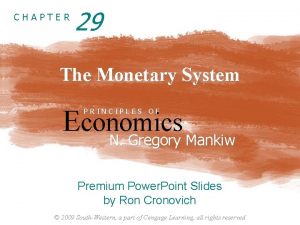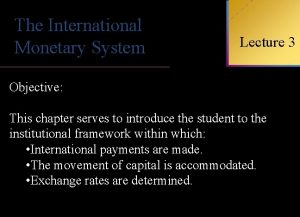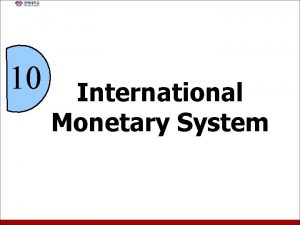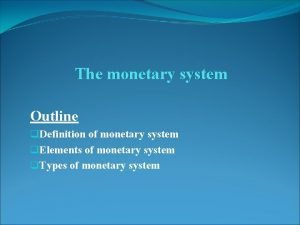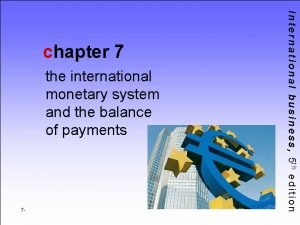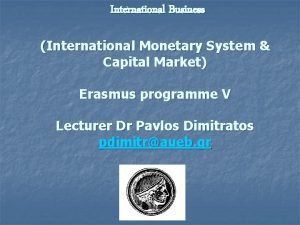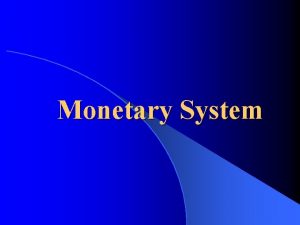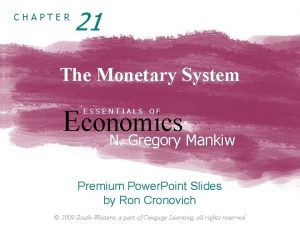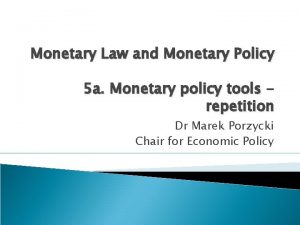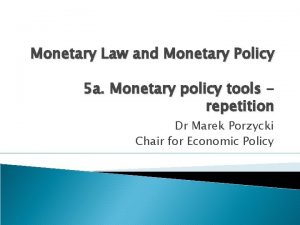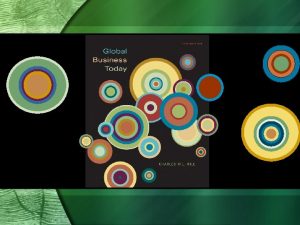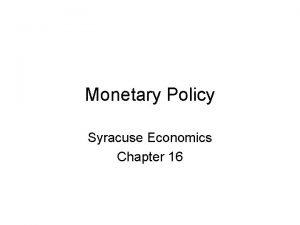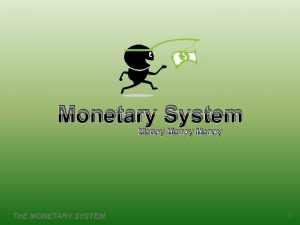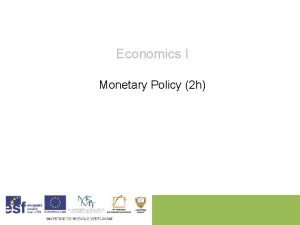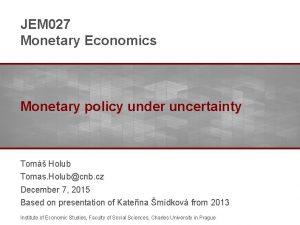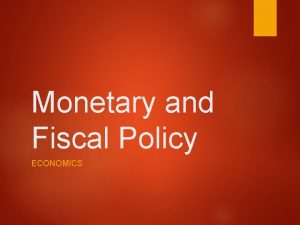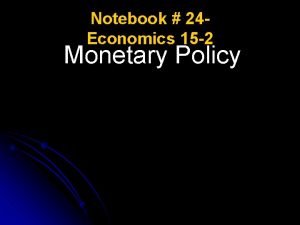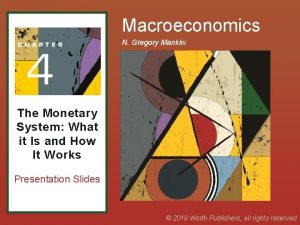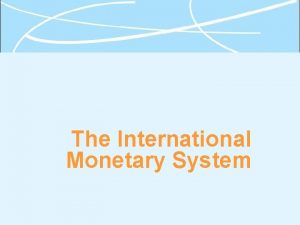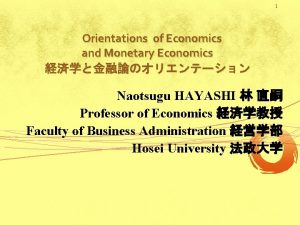CHAPTER 29 The Monetary System Economics N Gregory




































- Slides: 36

CHAPTER 29 The Monetary System Economics N. Gregory Mankiw PRINCIPLES OF N. Gregory Mankiw Premium Power. Point Slides by Ron Cronovich © 2009 South-Western, a part of Cengage Learning, all rights reserved

In this chapter, look for the answers to these questions: § What assets are considered “money”? What are the functions of money? The types of money? 화폐 란? 화폐의 기능은? 화폐의 유형은? § What is the Federal Reserve? 중앙은행은? § What role do banks play in the monetary system? How do banks “create money”? 통화제도에서 은행 의 역할은? 어떻게 은행은 통화를 창출하는가? § How does the Federal Reserve control the money supply? 중앙은행은 어떻게 화폐공급을 통제하는가 ? 1

What Money Is and Why It’s Important § Without money, trade would require barter, the exchange of one good or service for another. 화폐가 없다 면 교역을 위해 물물교환이 필요 § Every transaction would require a double coincidence of wants – the unlikely occurrence that two people each have a good the other wants. 모든 거래는 욕망의 이중적 일치를 필요로 함두 사람이 각자가 원하는 재화를 가지고 있기란 쉽지 않다. § Most people would have to spend time searching for others to trade with – a huge waste of resources. 대부분의 사람들은 물 건을 바꿀 사람을 찾아 헤매야 할 것이며 이는 엄청난 자원의 낭비를 가져올 것 § This searching is unnecessary with money, the set of assets that people regularly use to buy g&s from other people. 화폐가 있으면 이러한 탐색은 필요 없다. THE MONETARY SYSTEM 2

The 3 Functions of Money화폐의 3가지 기능 § Medium of exchange(교환의 매개): an item buyers give to sellers when they want to purchase g&s 구 매자가 재화나 서비스를 구매하고자 할 때 판매자에게 주는 아이템 § Unit of account(회계 단위): the yardstick people use to post prices and record debts 사람들이 가격을 매 기고 빚을 기록하는 척도 § Store of value(가치저장수단): an item people can use to transfer purchasing power from the present to the future 사람들이 구매력을 현재에서 미래로 이전하 고자 할 때 사용할 수 있는 수단 THE MONETARY SYSTEM 3

The 2 Kinds of Money Commodity money: takes the form of a commodity with intrinsic value Examples: gold coins, cigarettes in POW camps Fiat money: (법화) money without intrinsic value, used as money because of govt decree Example: the U. S. dollar THE MONETARY SYSTEM 4

The Money Supply화폐 공급 § The money supply (or money stock)화폐공급 또는 통화량: the quantity of money available in the economy 경제 내에서 사용 가능한 화폐의 양 § What assets should be considered part of the money supply? 어떤 자산이 화폐공급의 부분으로 간주되어야 하는가? Two candidates 두 가지 후보: § Currency(현금통화): the paper bills and coins in the hands of the (non-bank) public § Demand deposits(요구불 예금): balances in bank accounts that depositors can access on demand by writing a check THE MONETARY SYSTEM 5

Measures of the U. S. Money Supply § M 1: currency, demand deposits, traveler’s checks, and other checkable deposits. M 1 = $1. 4 trillion (June 2008) § M 2: everything in M 1 plus savings deposits, small time deposits, money market mutual funds, and a few minor categories. M 2 = $7. 7 trillion (June 2008) The distinction between M 1 and M 2 will usually not matter when we talk about “the money supply” in this course. THE MONETARY SYSTEM 6

Central Banks & Monetary Policy § Central bank: an institution that oversees the banking system and regulates the money supply § Monetary policy: the setting of the money supply by policymakers in the central bank § Federal Reserve (Fed): the central bank of the U. S. THE MONETARY SYSTEM 7

The Structure of the Fed The Federal Reserve System consists of: § Board of Governors (7 members), located in Washington, DC § 12 regional Fed banks, located around the U. S. § Federal Open Market Ben S. Bernanke Chair of FOMC, Feb 2006 – present Committee (FOMC), includes the Bd of Govs and presidents of some of the regional Fed banks The FOMC decides monetary policy. THE MONETARY SYSTEM 8

Bank Reserves(은행의 지급준비금) § In a fractional reserve banking system, banks keep a fraction of deposits as reserves and use the rest to make loans. 부분지금준비 은행제도에서 은행은 예금의 일부를 지급준 비로 보유하고 나머지를 대출 § The Fed establishes reserve requirements, regulations on the minimum amount of reserves that banks must hold against deposits. 중앙은행은 법정 지급준비금( 은행이 반드시 보유해야 하는 최소지급준비금)을 정함 § Banks may hold more than this minimum amount if they choose. § The reserve ratio, R 예금 중에서 은행이 지급준비금으로 보유 하는 금액의 비율 THE MONETARY SYSTEM 9

Bank T-account은행의 T계정 § T-account: a simplified accounting statement that shows a bank’s assets & liabilities. § Example: FIRST NATIONAL BANK Assets Liabilities Reserves $ 10 Deposits $100 Loans $ 90 § Banks’ liabilities include deposits, assets include loans & reserves. § In this example, notice that R = $10/$100 = 10%. THE MONETARY SYSTEM 10

Banks and the Money Supply: An Example Suppose $100 of currency is in circulation. 100달러의 현금이 유 통 중이라고 가정 To determine banks’ impact on money supply, we calculate the money supply in 3 different cases 은행이 화 폐공급에 미치는 영향을 알아보기 위해 3가지 다른 경우의 화폐공급을 계산: 1. No banking system 2. 100% reserve banking system: banks hold 100% of deposits as reserves, make no loans 3. Fractional reserve banking system THE MONETARY SYSTEM 11

Banks and the Money Supply: An Example CASE 1: No banking system Public holds the $100 as currency. Money supply = $100. THE MONETARY SYSTEM 12

Banks and the Money Supply: An Example CASE 2: 100% reserve banking system Public deposits the $100 at First National Bank (FNB). FNB holds 100% of deposit as reserves: FIRST NATIONAL BANK Assets Liabilities Reserves $100 Deposits $100 Loans $ 0 Money supply = currency + deposits = $0 + $100 = $100 In a 100% reserve banking system, banks do not affect size of money supply. THE MONETARY SYSTEM 13

Banks and the Money Supply: An Example CASE 3: Fractional reserve banking system Suppose R = 10%. FNB loans all but 10% of the deposit: FIRST NATIONAL BANK Assets Liabilities Reserves $100 10 Deposits Loans $ 90 0 Money supply = $190 (!!!) Depositors have $100 in deposits, Borrowers have $90 in currency. THE MONETARY SYSTEM 14

Banks and the Money Supply: An Example CASE 3: Fractional reserve banking system How did the money supply suddenly grow? When banks make loans, they create money. The borrower gets § $90 in currency (an asset counted in the money supply) § $90 in new debt (a liability) A fractional reserve banking system creates money, but not wealth 부분지급준비제 도는 통화를 창출한다. 그러나 부를 창출하는 것은 아니다. THE MONETARY SYSTEM 15

Banks and the Money Supply: An Example CASE 3: Fractional reserve banking system Suppose borrower deposits the $90 at Second National Bank (SNB). Initially, SNB’s T-account looks like this: SECOND NATIONAL BANK Assets Liabilities Reserves $ 90 9 Deposits Loans $ 81 0 If R = 10% for SNB, it will loan all but 10% of the deposit. THE MONETARY SYSTEM 16

Banks and the Money Supply: An Example CASE 3: Fractional reserve banking system The borrower deposits the $81 at Third National Bank (TNB). Initially, TNB’s T-account looks like this: THIRD NATIONAL BANK Assets Liabilities Reserves $ $8. 10 81 Deposits $ 81 Loans $72. 90 $ 0 If R = 10% for TNB, it will loan all but 10% of the deposit. THE MONETARY SYSTEM 17

Banks and the Money Supply: An Example CASE 3: Fractional reserve banking system The process continues, and money is created with each new loan. Original deposit = $ 100. 00 FNB lending = $ 90. 00 SNB lending = $ 81. 00 TNB lending = $ 72. 90. . . Total money supply = $1000. 00 THE MONETARY SYSTEM In this example, $100 of reserves generates $1000 of money. 18

The Money Multiplier § Money multiplier: the amount of money the banking system generates with each dollar of reserves § The money multiplier equals 1/R. § In our example, R = 10% money multiplier = 1/R = 10 $100 of reserves creates $1000 of money (Notice : 본원통화를 A, 지급준비율을 R이라하면 통화량 = A + A(1 -R)^2 + …. . = A(1/1 -(1 -R) = A/R) THE MONETARY SYSTEM 19

ACTIVE LEARNING 1 Banks and the money supply While cleaning your apartment, you look under the sofa cushion find a $50 bill (and a half-eaten taco). You deposit the bill in your checking account. 청소하다 50달러 발견하여 요구불 계좌에 저축 The Fed’s reserve requirement is 20% of deposits. R=20% A. What is the maximum amount that the money supply could increase? B. What is the minimum amount that the money supply could increase? 20

ACTIVE LEARNING 1 Answers You deposit $50 in your checking account. A. What is the maximum amount that the money supply could increase? If banks hold no excess reserves, then money multiplier = 1/R = 1/0. 2 = 5 The maximum possible increase in deposits is 5 x $50 = $250 But money supply also includes currency, which falls by $50. Hence, max increase in money supply = $200. 21

ACTIVE LEARNING 1 Answers You deposit $50 in your checking account. A. What is the maximum amount that the money supply could increase? Answer: $200 B. What is the minimum amount that the money supply could increase? Answer: $0 If your bank makes no loans from your deposit, currency falls by $50, deposits increase by $50, money supply does not change. 22

The Fed’s 3 Tools of Monetary Control 1. Open-Market Operations (공개시장조작): the purchase and sale of U. S. government bonds by the Fed. § To increase money supply, Fed buys govt bonds, paying with new dollars. …which are deposited in banks, increasing reserves …which banks use to make loans, causing the money supply to expand. § To reduce money supply, Fed sells govt bonds, taking dollars out of circulation, and the process works in reverse. THE MONETARY SYSTEM 23

The Fed’s 3 Tools of Monetary Control 1. Open-Market Operations (OMOs): the purchase and sale of U. S. government bonds by the Fed. § OMOs are easy to conduct, and are the Fed’s monetary policy tool of choice. THE MONETARY SYSTEM 24

The Fed’s 3 Tools of Monetary Control 2. Reserve Requirements (RR): affect how much money banks can create by making loans. § To increase money supply, Fed reduces RR. Banks make more loans from each dollar of reserves, which increases money multiplier and money supply. § To reduce money supply, Fed raises RR, and the process works in reverse. § Fed rarely uses reserve requirements to control money supply: Frequent changes would disrupt banking. THE MONETARY SYSTEM 25

The Fed’s 3 Tools of Monetary Control 3. The Discount Rate(재할인율): the interest rate on loans the Fed makes to banks § When banks are running low on reserves, they may borrow reserves from the Fed. § To increase money supply, Fed can lower discount rate, which encourages banks to borrow more reserves from Fed. § Banks can then make more loans, which increases the money supply. § To reduce money supply, Fed can raise discount rate. THE MONETARY SYSTEM 26

The Fed’s 3 Tools of Monetary Control 3. The Discount Rate: the interest rate on loans the Fed makes to banks § The Fed uses discount lending to provide extra liquidity when financial institutions are in trouble, e. g. after the Oct. 1987 stock market crash. § If no crisis, Fed rarely uses discount lending – Fed is a “lender of last resort. ” THE MONETARY SYSTEM 27

The Federal Funds Rate(기준금리) § On any given day, banks with insufficient reserves can borrow from banks with excess reserves. 지급준비금이 부족 한 은행이 남는 은행에게 빌릴 수 있으며, § The interest rate on these loans is the federal funds rate. 이 때 적용되는 금리가 기준금리이다. § The FOMC uses OMOs to target the fed funds rate. 공개 시장위원회는 기준금리를 타깃으로 공개시장조작을 한다. § Many interest rates are highly correlated, so changes in the fed funds rate cause changes in other rates and have a big impact in the economy. 다양한 금리들은 서로 긴밀히 연관되 어 있어서 기준금리의 변화는 다른 금리의 변화를 초래하여 경제에 큰 영향 을 미친다. THE MONETARY SYSTEM 28

The Fed Funds Rate and Other Rates, 19702008 Fed funds 20 prime 3 -month Tbill 15 (%) mortgage 10 5 0 1975 1980 1985 1990 1995 2000 2005

Monetary Policy and the Fed Funds Rate To raise fed funds rate, Fed sells Federal funds rate govt bonds (OMO). This removes reserves from the banking system, reduces supply of federal funds, causes rf to rise. rf The Federal Funds market S 2 S 1 3. 75% 3. 50% D 1 F 2 F 1 Quantity of federal funds THE MONETARY SYSTEM F 30

Problems Controlling the Money Supply § If households hold more of their money as currency, banks have fewer reserves, make fewer loans, and money supply falls. 가계가 돈을 현금으로 더 많이 보유할수록 은행의 준비금은 줄어들어 대출이 줄고 화폐공급은 줄어든다. § If banks hold more reserves than required, they make fewer loans, and money supply falls. 은행이 초과 지급준비금을 가지고 있을 경우에도 대출이 줄고 화폐공급이 준다. § Yet, Fed can compensate for household and bank behavior to retain fairly precise control over the money supply. 그러나 중앙은행은 통화공급에 대한 정밀한 통제를 유지하기 위하 여 가계와 은행의 행동을 상쇄할 수 있다. THE MONETARY SYSTEM 31

Bank Runs and the Money Supply § A run on banks: When people suspect their banks are in trouble, they may “run” to the bank to withdraw their funds, holding more currency and less deposits사람들이 자신의 은행이 문제가 있다고 의심하게 될 때 그들은 은행으로 달려가서 가능한 한 많은 현금을 확 보하려 할 것이다. § Under fractional-reserve banking, banks don’t have enough reserves to pay off ALL depositors, hence banks may have to close. 부분지준제도하에서 은행은 모든 예금자에게 돈을 지불할 수 없기 때문에 은행문을 닫아야 한다. § Also, banks may make fewer loans and hold more reserves to satisfy depositors. 물론 은행은 예금자를 안심시키기 위해 대출을 줄여 더 많은 준비금을 보유할 수도 있다. § These events increase R, reverse the process of money creation, cause money supply to fall. 그러면 화폐공금이 감소 32

Bank Runs and the Money Supply § During 1929 -1933, a wave of bank runs and bank closings caused money supply to fall 28%. § Many economists believe this contributed to the severity of the Great Depression. § Since then, federal deposit insurance has helped prevent bank runs in the U. S. § In the U. K. , though, Northern Rock bank experienced a classic bank run in 2007 and was eventually taken over by the British government. THE MONETARY SYSTEM 33

CHAPTER SUMMARY § Money includes currency and various types of bank deposits. § The Federal Reserve is the central bank of the U. S. , is responsible for regulating the monetary system. § The Fed controls the money supply mainly through open-market operations. Purchasing govt bonds increases the money supply, selling govt bonds decreases it. 34

CHAPTER SUMMARY § In a fractional reserve banking system, banks create money when they make loans. Bank reserves have a multiplier effect on the money supply. 35
 Chapter 29 the monetary system
Chapter 29 the monetary system International monetary system
International monetary system Objectives of international monetary system
Objectives of international monetary system Bimetallic standard
Bimetallic standard International monetary system
International monetary system International monetary system
International monetary system Maastricht university school of business and economics
Maastricht university school of business and economics Econ213
Econ213 Hát kết hợp bộ gõ cơ thể
Hát kết hợp bộ gõ cơ thể Lp html
Lp html Bổ thể
Bổ thể Tỉ lệ cơ thể trẻ em
Tỉ lệ cơ thể trẻ em Voi kéo gỗ như thế nào
Voi kéo gỗ như thế nào Tư thế worm breton
Tư thế worm breton Hát lên người ơi alleluia
Hát lên người ơi alleluia Môn thể thao bắt đầu bằng chữ f
Môn thể thao bắt đầu bằng chữ f Thế nào là hệ số cao nhất
Thế nào là hệ số cao nhất Các châu lục và đại dương trên thế giới
Các châu lục và đại dương trên thế giới Công thức tính thế năng
Công thức tính thế năng Trời xanh đây là của chúng ta thể thơ
Trời xanh đây là của chúng ta thể thơ Mật thư anh em như thể tay chân
Mật thư anh em như thể tay chân 101012 bằng
101012 bằng Phản ứng thế ankan
Phản ứng thế ankan Các châu lục và đại dương trên thế giới
Các châu lục và đại dương trên thế giới Thơ thất ngôn tứ tuyệt đường luật
Thơ thất ngôn tứ tuyệt đường luật Quá trình desamine hóa có thể tạo ra
Quá trình desamine hóa có thể tạo ra Một số thể thơ truyền thống
Một số thể thơ truyền thống Cái miệng bé xinh thế chỉ nói điều hay thôi
Cái miệng bé xinh thế chỉ nói điều hay thôi Vẽ hình chiếu vuông góc của vật thể sau
Vẽ hình chiếu vuông góc của vật thể sau Thế nào là sự mỏi cơ
Thế nào là sự mỏi cơ đặc điểm cơ thể của người tối cổ
đặc điểm cơ thể của người tối cổ Thế nào là giọng cùng tên?
Thế nào là giọng cùng tên? Vẽ hình chiếu đứng bằng cạnh của vật thể
Vẽ hình chiếu đứng bằng cạnh của vật thể Phối cảnh
Phối cảnh Thẻ vin
Thẻ vin đại từ thay thế
đại từ thay thế điện thế nghỉ
điện thế nghỉ
